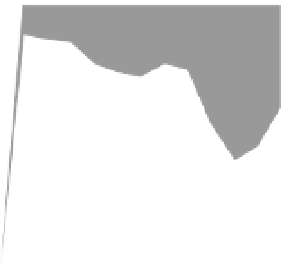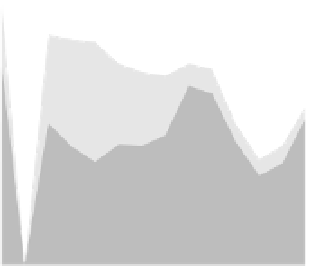Environmental Engineering Reference
In-Depth Information
(a)
(b)
(c)
100
bare
80
60
40
20
0
1972
1984 1972
1985 1972
1985
(d)
(e)
Ploughing 20 cm
Ploughing 60 cm
100
80
60
woodland
heathland
40
eutrophic, changing groundwater, pasture
mesotrophic, dry, hay pasture
20
mesotrophic, wet, hay field
eutrophic, moist, hay pasture
pioneers
0
1978
1985
1978
1985
Fig. 8.5
Relative changes of cover percentages of ecological groups after (a) grazing, (b) haymaking and (c) sod
cutting from 1972 onwards, and ploughing up to (d) 20 cm and (e) 60 cm from 1978 onwards.
8.6.6 Sod cutting
the grasshopper warbler
Locustella naevia
(Bijlsma
2001). It is under discussion whether managers should
change targets depending on unexpected events.
To enhance the restoration of oligotrophic grassland
and heathland, sod cutting (up to 10 cm) is practised.
It does remove nutrients and enhances the establish-
ment of target species from the soil seed bank if pre-
sent (Fig. 8.5). The disadvantage of sod cutting is that
it removes part of the soil seed bank including target
species. However, shallow sod cutting of up to 10 cm
can also activate the seed bank of non-target species.
A headache for many authorities in charge of con-
servation is the establishment of
Juncus effusus
. This
rush species is represented in most soil samples in (for-
mer) agricultural fields in north-west Europe (Bekker
et al
. 1997). However, sometimes the dominance of
J. effusus
is judged to be positive, as the stands har-
bour many reptiles (Donker 1999) and birds such as
8.6.7 Topsoil removal
In the early 1990s waste deposits had to be covered
by soil in the Netherlands. This was for sanitary
reasons as birds dispersed waste over the countryside.
The process resulted in topsoil removal (up to 50 cm)
in several nature reserves. Topsoil removal gives the
opportunity to get rid of the whole former agricul-
tural history by removing the ploughed and fertilized
soil until the C horizon (the undisturbed parent mater-
ial) and to start succession with oligotrophic soil con-
ditions. Of course, the seed bank of target species is






















